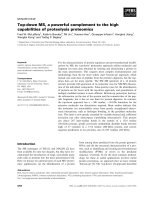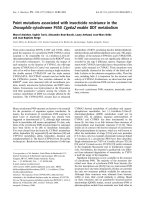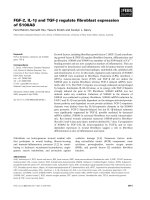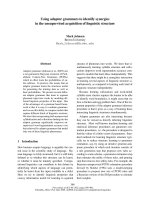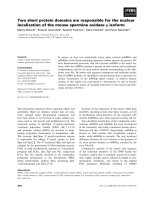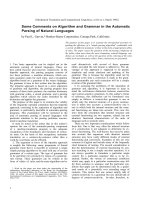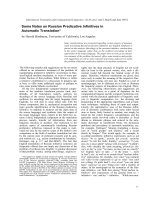Báo cáo khoa học: "Some Comments on Algorithm and Grammar in the Automatic Parsing of Natural Languages" ppt
Bạn đang xem bản rút gọn của tài liệu. Xem và tải ngay bản đầy đủ của tài liệu tại đây (105.89 KB, 2 trang )
[Mechanical Translation and Computational Linguistics, vol.9, no.1, March 1966]
Some Comments on Algorithm and Grammar in the Automatic
Parsing of Natural Languages
by Paul L. Garvin,* Bunker-Ramo Corporation, Canoga Park, California
The purpose of this paper is to examine the oft-repeated assertion re-
garding the efficiency of a "simple parsing algorithm" combinable with
a variety of different grammars written in the form of appropriate tables
of rules. The paper raises the question of the increasing complexity of
the tables when more than the most elementary natural-language con-
ditions are included, as well as the question of the ordering of the rules
within such non-elementary tables. Some conclusions are presented.
1. Two basic approaches can be singled out in the
automatic parsing of natural languages. These are
here called bipartite and tripartite, respectively. In the
bipartite approach, the parsing program consists of
two basic portions: a machine dictionary which con-
tains grammar codes for each entry, and a recognition
algorithm based on a grammar of the source language;
the grammar is here in fact written into the algorithm.
The tripartite approach is based on a strict separation
of grammar and algorithm; the parsing program here
consists of three basic portions: the machine dictionary
with grammar codes, a stored grammar, and a parsing
algorithm which utilizes the codes furnished by the
dictionary and applies the grammar.
The purpose of this paper is to examine the validity
of the frequently repeated contention that the tripartite
approach, consisting in the separation of algorithm and
grammar, is particularly desirable in automatic-parsing
programs. This examination will be restricted to the
area of automatic parsing of natural languages with
particular attention to the parsing problems encoun-
tered in machine translation.
It must be noted at the outset that in this author’s
opinion the aim of the automatic-parsing component
of a machine-translation program is the adequate
recognition of the boundaries and functions of syntac-
tic units. On the basis of this recognition, automatic
translation on a sentence-by-sentence rather than a
word-by-word basis can be effected.
2. The argument in favor of the tripartite approach
is roughly the following: many proponents of formal
grammar claim that it is possible to construct a single
simple parsing algorithm to be used with any of several
grammars of a certain type. The type of grammar has
to be specified very precisely by means of a grammar-
rule format. These grammars can be written in the
form of tables of rules, and the same algorithm can be
* Work on this paper was done under the sponsorship of the
Information Processing Laboratory of the Rome Air Development
Center of the United States Air Force, under Contract AF30(602)-
3506. An earlier version of this paper was presented at the 1965
International Conference on Computational Linguistics, New York,
May 19-21.
used alternatively with several of these grammar
tables, provided the rule format is adhered to. The ad-
vantage of this approach is supposed to be greater
simplicity and easier checkout and updating of the
grammar. This is because the algorithm need not be
changed every time a correction is made in the gram-
mar: presumably any such correction will be a simple
revision of the grammar table.
3. In assessing the usefulness of the separation of
grammar and algorithm, it is important to keep in
mind the well-known distinction between context-free
and context-sensitive grammars. In this author’s frame
of reference, this distinction can be formulated very
simply as follows: a context-free grammar is one in
which only the internal structure of a given construc-
tion is taken into account; a context-sensitive one is
one in which both the internal structure and the exter-
nal functioning are taken into account. This view fol-
lows from the conception that internal structure and
external functioning are two separate, related, but not
identical, functional characteristics of the units of
language such as syntactic units.
There are two important considerations which follow
from this. One is that very often the internal structure
of a construction is not adequate to determine its ex-
ternal functioning. The well-known fact must be taken
into account that sequences with identical internal
structure may have vastly different modes of external
functioning and conversely. Examples of this are very
common in English and include many of the frequently
cited instances of nesting. The second consideration is
that the determination of external functioning by con-
text searching is not a simple one-shot operation. It is
not always possible to formulate a particular single
context for a particular sequence that is to be ex-
amined. Rather, the variety of contextual conditions
which may apply to a particular construction may dif-
fer from sentence to sentence, and the particular con-
ditions that apply can be determined only by a gradu-
ated search of a potentially ever extending range of
contexts. This means that one cannot simply talk of
context-sensitivity in a grammar but one should talk of
degrees of context-sensitivity. In order, therefore, to
2
parse natural-language data adequately, the parsing
system has to have not merely some fixed capability of
being sensitive to a certain range of contexts but a
capacity to increase its context-sensitivity.
This means that the most significant alterations in
grammar rules from the standpoint of natural-language
parsing will not be those that affect the formation of
particular rules within the same format. Rather, those
alternatives that will really make a difference in the
adequacy of the parsings of natural-language sentences
will be alterations of the format itself in terms of in-
creasing the degree of context-sensitivity. This in effect
means that the simplicity claimed for a separate table
of rules with a constant algorithm turns out to be il-
lusory, since the proponents of this concept of simplic-
ity admit that it applies only when the rules are held to
the same format.
4. Another point raised in connection with the
separation of grammar and algorithm is that the gram-
mar table constitutes a set of input data to the particu-
lar algorithm, in a similar way in which the sentences
to be parsed constitute input data. In this author’s
opinion, this is again an oversimplification.
First of all, it is to be noted that, in the view of
many programmers, only those data are considered in-
put that are designed to be actually processed. Since
the grammar rules are not intended to be subject to
processing, but rather to constitute the parameters for
processing, they are not input data in any way com-
parable to the sentences that are to be parsed.
If, on the other hand, the question of processing is
to be ignored in deciding what is to be viewed as in-
put data, then another consideration must be taken
into account. It is the following: the question as to
what constitutes input can not be answered in the ab-
solute, but only relatively. That is, the question is not
simply “Is it input?” but “What is it input to?” This
means that the answer depends, at least in part, on
what portions of the program are previously present
in the work space and what additional portions are in-
putted subsequently. In a bipartite program in which
the grammar is written into the algorithm, such as is
the case in the approach this author has taken, the
question of whether the grammar constitutes input
data can then be viewed as follows: while the gram-
mar does not constitute a separate set of input data, it
nevertheless will use separate sets of grammatical in-
put data in the form of a grammar-coded dictionary
that is fed into the program from a separate source.
Likewise, it is possible to view the executive routine
of the algorithm which contains the grammar as the
actual parsing algorithm and to view the remaining
portions as forms of input data.
5. Leaving aside the matters of rule format and
input data, two further questions can be raised con-
cerning the simplicity that is claimed to result from
the separation of grammar and algorithm. These ques-
tions are pertinent in the case of a grammar having
sufficient context-sensitivity to serve the needs of syn-
tactic recognition adequate for the machine translation
of natural languages.
a) Since the table will tend to be increasingly com-
plex because of the requirement of high context-sensi-
tivity, a dictionary-type binary lookup may no longer
be sufficient. Rather, it may become necessary to de-
vise an algorithm for searching the table in such a
way that the graduation of contextual conditions is
taken into account properly.
b) Revisions of the rules in such a complex table
will not be as simple a matter as it seems, because it
will no longer be obvious which of the rules is to be
modified in a given case, nor will it be obvious where
in the table this rule can be found. Likewise, it will
not be obvious what contextual conditions will have to
be taken into account in order to bring about the de-
sired modification.
6. As can be seen, the argument in favor of the
separation of grammar and algorithm is considered far
from convincing. It does raise a related question, how-
ever: If the major separation is not to be that between
grammar and algorithm, what then are the major com-
ponents of a parsing program?
The answer which this author has found satisfactory
is the well-known one of structuring the parsing pro-
gram as an executive main routine with appropriate
subroutines. This raises the further question of the
functions and design of the executive routine and sub-
routines.
In this type of parsing program, the function of the
executive routine will be to determine what units to
look for and where to look for them. The aim of the
subroutines will be to provide the means for carrying
out the necessary searches.
The design principle for such a parsing program
will be the well-known one of functional subroutiniza-
tion: the program will contain a set of self-contained
and interchangeable subroutines designed to perform
individual functions.
The subroutines will be of two kinds: analytic sub-
routines, the purpose of which will be to perform tasks
of linguistic analysis such as the determination of the
internal structure and external functioning of the dif-
ferent constructions that are to be recognized, and
housekeeping subroutines, which are to insure that the
program is at all times aware of where it stands. The
latter means the following: the program has to know
what word it is dealing with; the program has to know
at each step how far a given search is allowed to go
and what points it is not allowed to go beyond; the
program has to be informed at all times of the neces-
sary location information, such as sentence boundaries,
word positions in the sentence, search distances, etc.
Received July 15, 1965
AUTOMATIC PARSING OF NATURAL LANGUAGES 3
